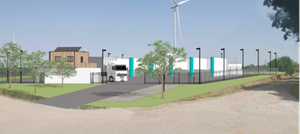News
Lhyfe obtains construction permit for its second green and renewable hydrogen production site
Lhyfe has obtained the construction permit for its second green and renewable H2 production site in the Morbihan region of Brittany, France, and is about to begin preparatory construction work. Lhyfe Bretagne, which should be operational by the second half of 2023, will mainly supply H2 for transport in the region and the industrial processes of regional companies. Lorient Agglomération has already defined its green H2 needs and will be the first area in Brittany to benefit from the H2 produced at the Lhyfe site. Lhyfe Bretagne is part of the VHyGO project, supported by ADEME.
Lhyfe is taking a new step forward with the announcement of the construction of its second green and renewable H2 production plant, in Brittany. This announcement marks the beginning of a long series of deployments for Lhyfe, which aims to have over 3 GW of installed capacity by 2030.
In Buléon, in the Morbihan region, Lhyfe will produce green and renewable–or in other words totally carbon-free–H2 for local uses, by electrolysis of water using resources and energy sourced nearby. To launch this project, Lhyfe has identified a plot of land of approximately 6,800 m2 adjacent to a wind farm.
Now that the building permit has been obtained, civil engineering work can begin at the end of February, with commissioning scheduled for the second half of 2023. Lhyfe Bretagne will have the capacity to produce up to 2 tpd of green and renewable H2 (5 MW). Its central location will enable Lhyfe to supply its customers across almost all of Brittany–within a radius of about 150 km–in keeping with its short supply chain philosophy.
Under the VHyGO or Great West H2 Valley initiative, supported by public and private players in the west of France, Lhyfe Bretagne will supply two refueling stations operated by HyGO in the Lorient area–one at the Lorient bus depot and the other, open to the public, on the left bank of the Scorff, for maritime purposes. Eventually, 19 buses and two passenger transport boats (known as Transrades) could be powered by this clean and local energy in the Lorient conurbation. These H2-powered Transrades will be a first in France. Lorient Agglomération is actively participating in ecological transition by renewing its fleet of public transport vehicles. It aims for its fleet to be made up entirely of clean vehicles in 2030 and to achieve carbon neutrality in 2050, with the migration of buses (80% of the fleet will have BioGNV engines and 20% renewable H2 fuel cell engines) and ships (with the arrival of H2-powered sea buses).
As well as decarbonizing uses, this project has a strong regional dimension as it is helping to build a H2-related industry:
- Development of land-based uses as well as maritime and industrial H2 applications
- Development of the local training offer (degree in energy, electrical and H2 engineering from the Southern Brittany University (UBS)
- Increase in skills of numerous companies in the H2 field (construction, operation and maintenance of H2 infrastructure, and particularly of vehicles and boats)
- Provision of clean energy through the development of public H2 filling stations in Brittany.
Pierre Bouédo, Mayor of Buléon, said, “We are proud to welcome the first green and renewable H2 production site in Brittany to Buléon. We are all the more proud as green and renewable H2 is just beginning to be deployed in France and throughout the world. The central location of Buléon will allow the whole region to gain in energy independence and to pursue the transition that is needed and that our citizens expect from us.”
Fabrice Loher, President of Lorient Agglomeration and Mayor of Lorient, said, “In 2023, Lorient Agglomération will accelerate its ecological and energy transition, via the decarbonization of its land and sea transport. This transition is necessary to achieve energy sobriety, and even sovereignty, for our area. This year will see the deployment of an integrated local renewable H2 chain, from production to use, including research and development, innovation and training. The various building blocks of this new strategic sector are being put in place. Next autumn, the first seven H2 buses will be on the road and fueled by the H2 production facility in Buléon. In parallel, ENSIBS, the South Brittany University National Engineering School, is launching the first engineering degree in France in the field of energy and H2 in apprenticeship mode, to better align the region’s training offer with the future needs of companies in the energy sector. By promoting innovation and building on the structuring of new strategic sectors such as renewable H2, Lorient Agglomération is strengthening its position as a major economic player in Brittany.”
Maud Augeai, Director of Territorial Development France at Lhyfe, said, “The Great West H2 Valley or VHyGO project, which aims to democratize access to green and renewable H2 in the west of France region, is a formidable vector for accelerating the sector. We are keen to participate, with our public and private partners, in the construction of a H2-related industry in Morbihan and, more widely, in Brittany. Green and renewable H2 is now a reality. Many ecosystems are being structured nationally and in Europe, in which Lhyfe is actively involved.”


